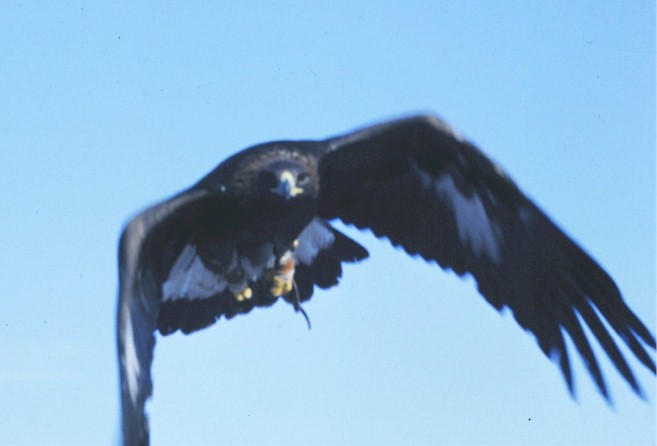(Several photos follow the narrative below.}
Ithaca was hatched 13 May 1972 at Cornell University, Ithaca, NY. He was named after the town of Ithaca, a Greek name which, according to a local librarian who I consulted at the time, means "a rugged place suitable only for pasturing goats." He had to be euthanized 29 September 2009 because of complications resulting from West Nile Virus.
It is sad that he encountered and suffered from the virus, that we lost him, and that he died so young (only 37 years old -- he otherwise probably would have lived many more years and I expected that he would outlive me). As a biologist, however, I'm familiar with life (and death) and understand that it's all in the nature of biology.
Ithaca resulted from an extracurricular project I conducted on captive breeding of eagles. (My primary, dissertation research at Cornell was on avian thermal regulation and physiology.) He was the second of three chicks that hatched in the project. The other two died prematurely when a shipping container used to transport them overheated. Ithaca almost also died in the same accident, but I discovered the problem in time while he was still alive and managed to rehabilitate him as a young chick. Cornell University produced a news release (click here) and the story was widely reported in the news at the time. National Wildlife magazine published an article on the work in the 1972 Oct-Nov issue, pages 44-45. The story was included in the latest editions of a book by Fran Hamerstrom, "An Eagle to the Sky" (Iowa State Univ Press, out of print). (Fran owned the two adult golden eagles that were Ithaca's parents, see photo below.) If interested in more details and photos, in a reprint of a report I wrote on the project, click here.
Eagles were a family affair at our home. My wife, Joyce, helped raise and take care of Ithaca. She and both of our kids, Karlene and Dean, also helped with my field work on eagles, particularly bald eagles (for examples, reprints of bald eagle articles from a cover article in Science [cover photo, article] and other journals [1, 2]). Ithaca was raised with the family (and vice versa -- the kids were raised with Ithaca) where he lived at our home or, part of the time, in a neighbor's barn for 30 years. When I or Joyce were not home to take care of him, he was housed and fed by our good friends and neighbors Terry Christensen (in Iowa) and Ron and Marie Opatril (in Minnesota). I flew him free for exercise, as in falconry.
He gained world-wide attention, made an appearance on the Johnny Carson Tonight Show (1977), was featured in numerous television segments, magazines, and newspaper articles through the years. I annually brought him to an introductory zoology class that I taught at North Dakota State University. I also gave frequent presentations with him and we traveled far and wide. In addition to the estimated 21 million people who saw him on the Carson show, I estimate that somewhere between 10,000 and 15,000 students and persons at talks were able to see him up close and touch him. He was a local celebrity and regional mascot. Eventually I became busier with frequent trips to the Philippines to work with Philippine eagles (click here for reprint of a paper on that work); Ithaca was spending more time in the barn; and he wasn't able to be seen by as many people. So in 2002 I transferred him to the Chahinkapa Zoo (and on facebook) and the care of a former student and my good friends, Kathy Diekman and Tom Schmaltz (along with several zookeepers) in Wahpeton, ND, where he was placed on display, used in traveling presentations, and was again seen by many thousands of people.
Unfortunately, he contracted West Nile Virus, presumably from a mosquito bite, during the fall of 2002 and nearly died at the time. After intense, on-going rehabilitation efforts lasting for several months, however, he made a fairly good recovery except that he remained blind as a result of the disease. He regained normal posture, molting, and feeding and returned to being suitable for display and traveling presentations. Then, during mid-to late summer of 2009 he began showing further complications from the West Nile Virus, rapidly declined in health during September, and finally had to be euthanized. He is missed by our family, NDSU, everyone at Chahinkapa Zoo, and the larger community of eastern North Dakota and northwestern Minnesota.
Here are a few photos through the years ...............
A picture of me holding him (middle) and the other two chicks right after hatching.

Our "three kids" looking at each other. Left, Karlene (age 5) and Ithaca (picture that accompanied the Cornell news release). Right, Dean (age 3) and Ithaca.
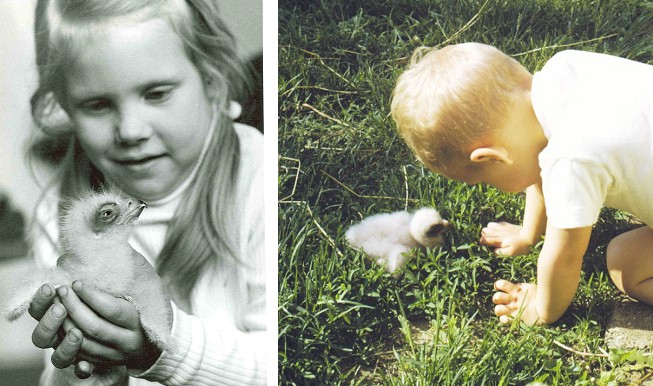
Ithaca growing up and exercising his wings on artificial nest in our back yard (living in Iowa at the time).
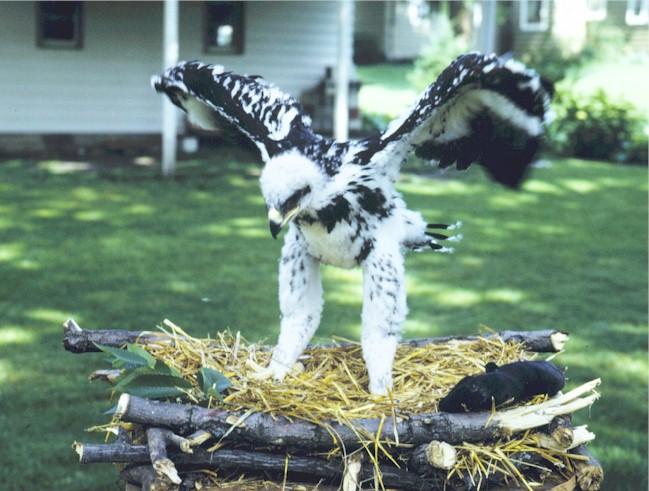
Fran Hamerstrom, right, holding Ithaca, and I, left, holding Ithaca's parents (borrowed from Fran for the project) in Plainfield, Wisconsin.
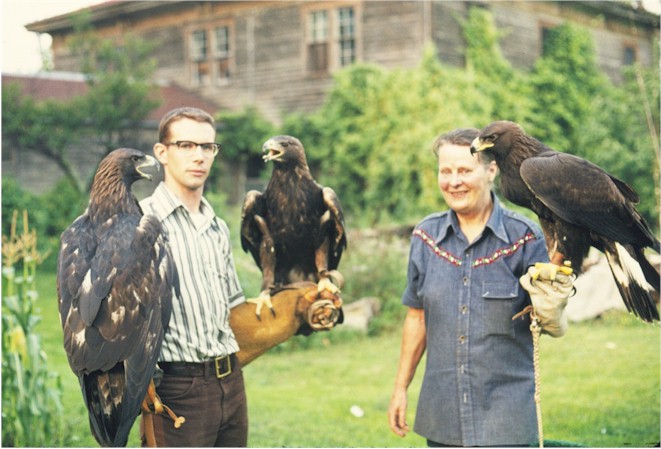
Flying Ithaca for exercise.

Ithaca on the Carson show.
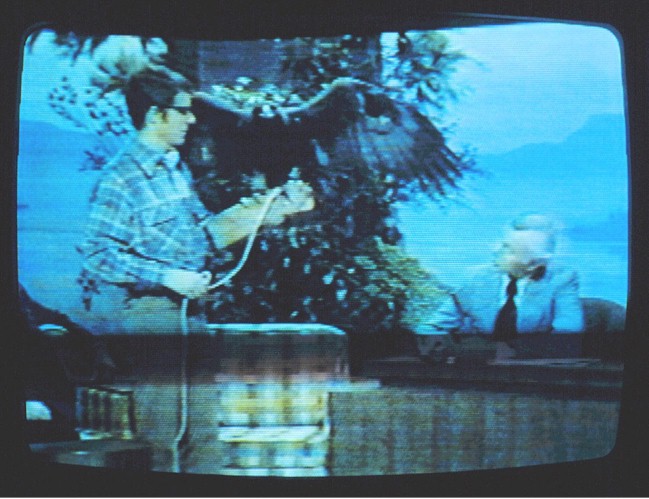
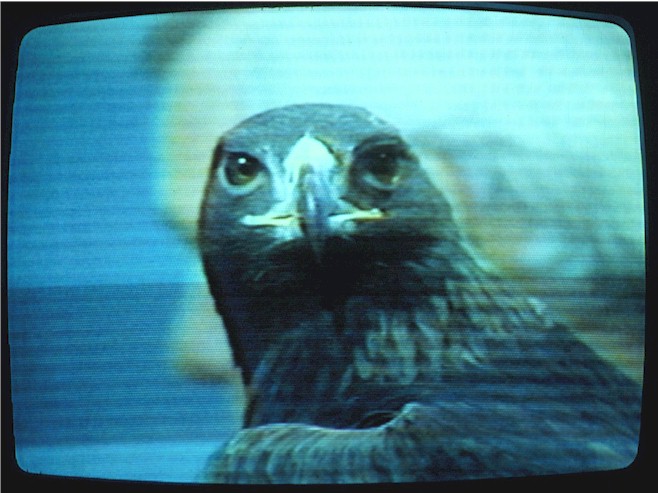
Ithaca with students in class.
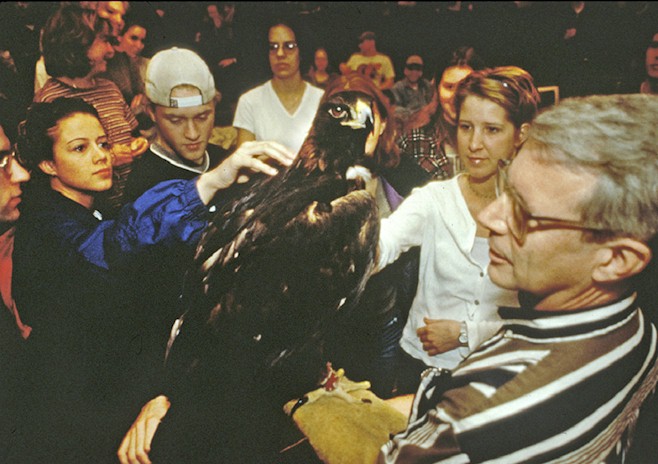
Ithaca in the snow.
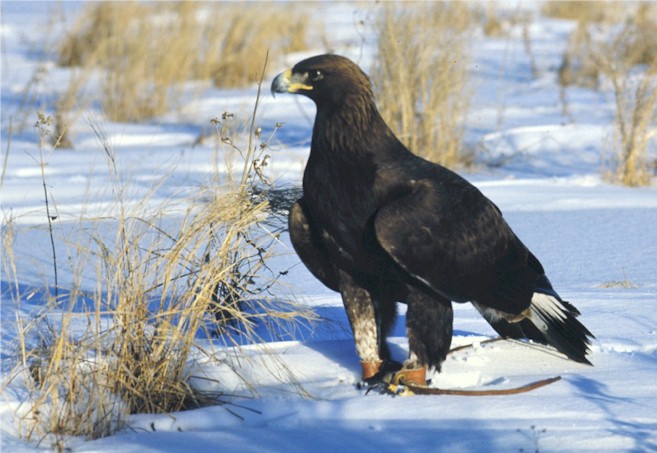
And in the sky.
